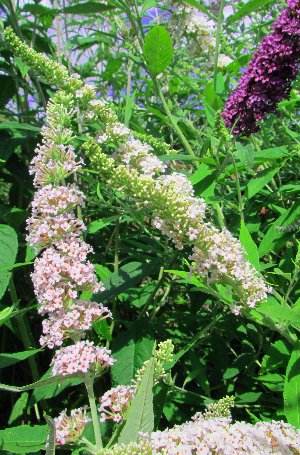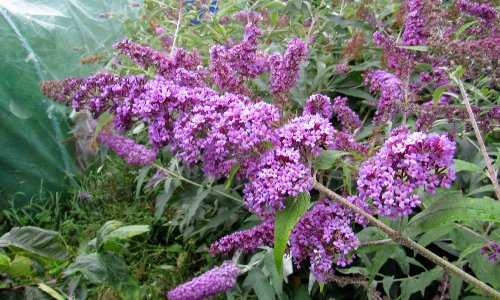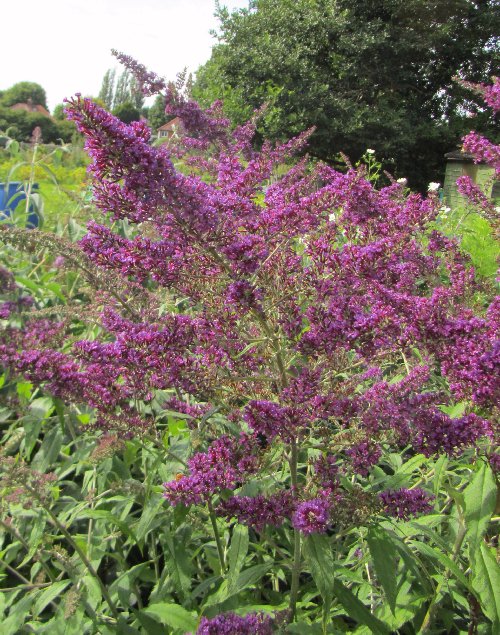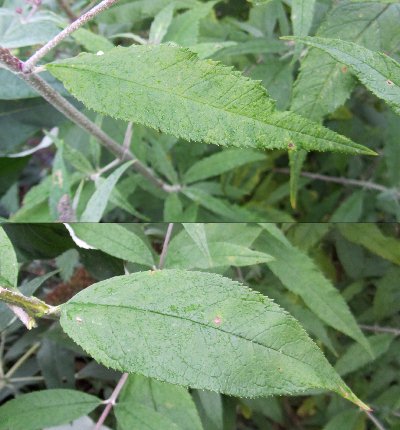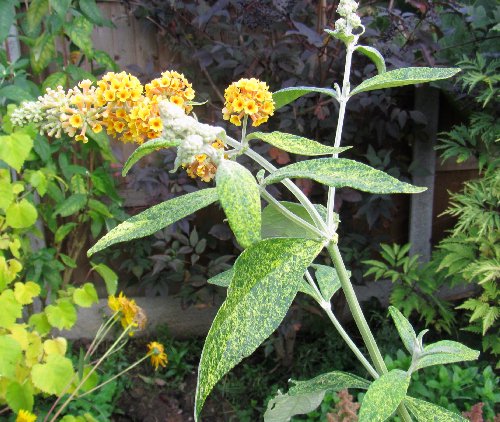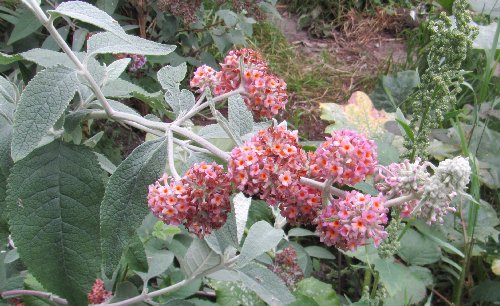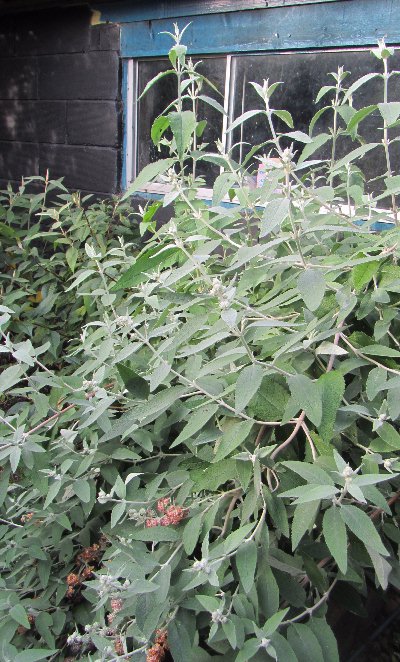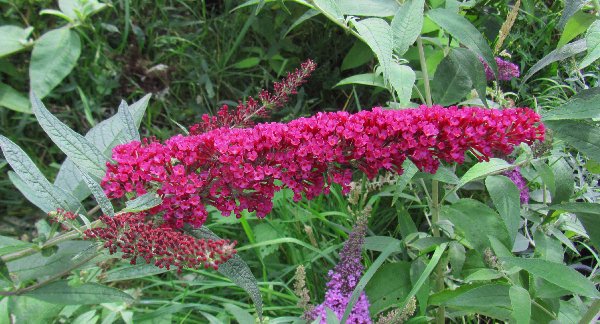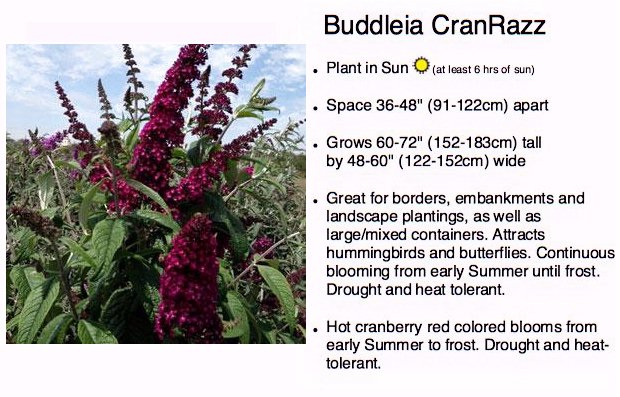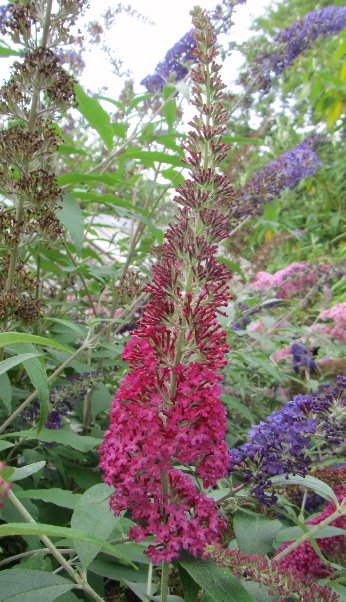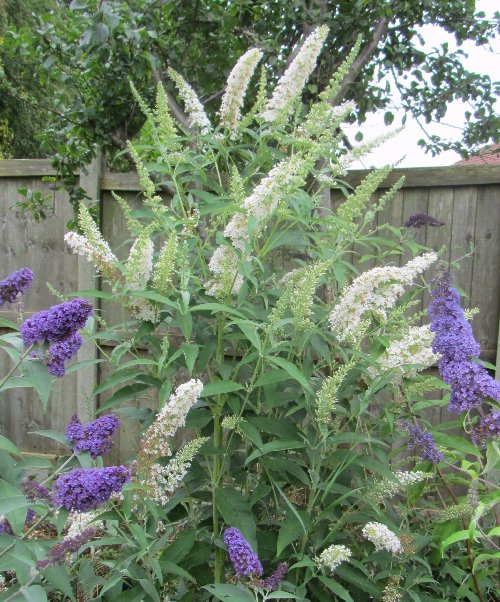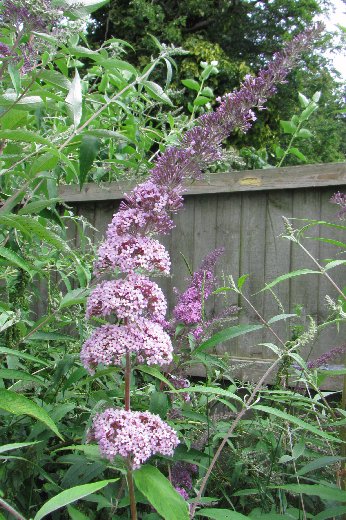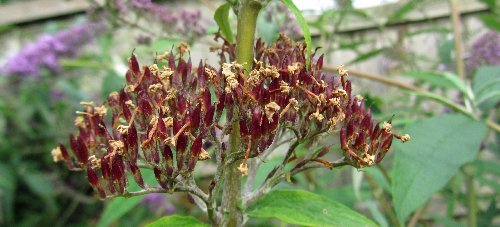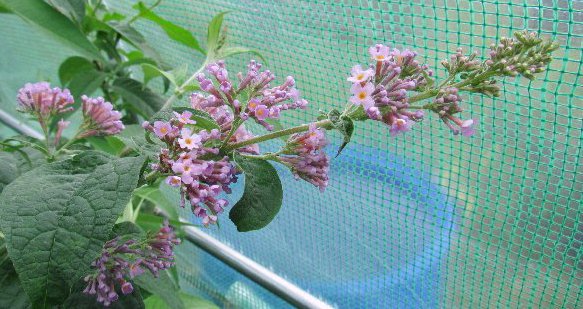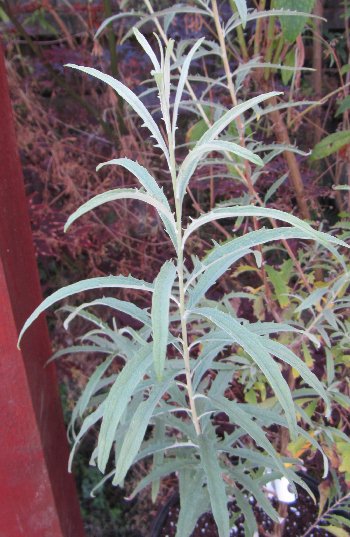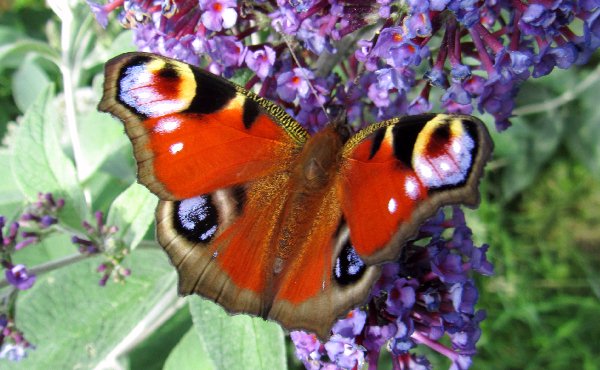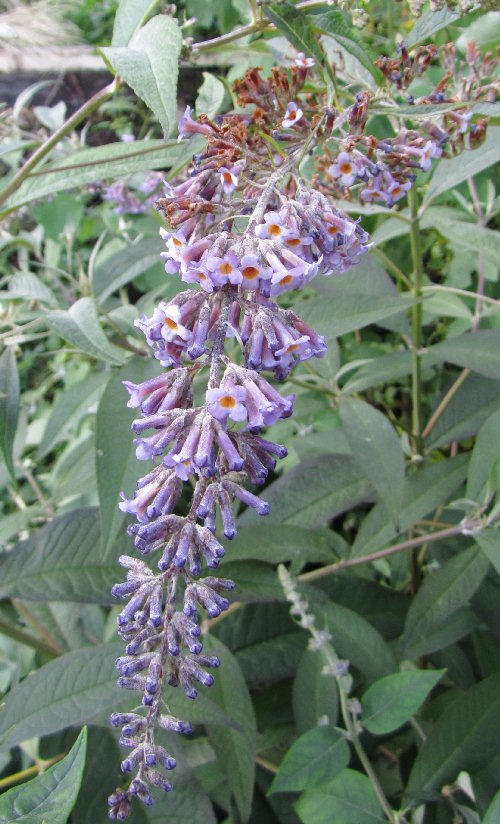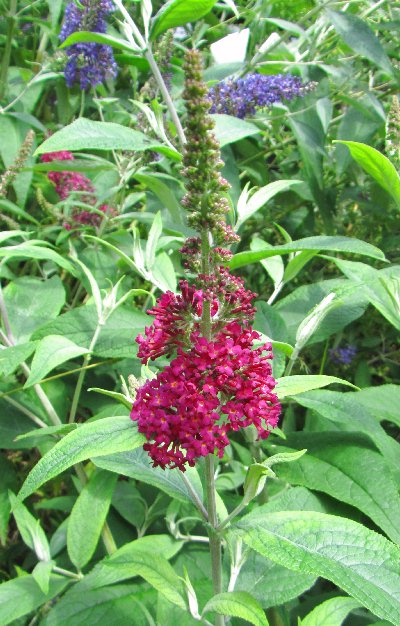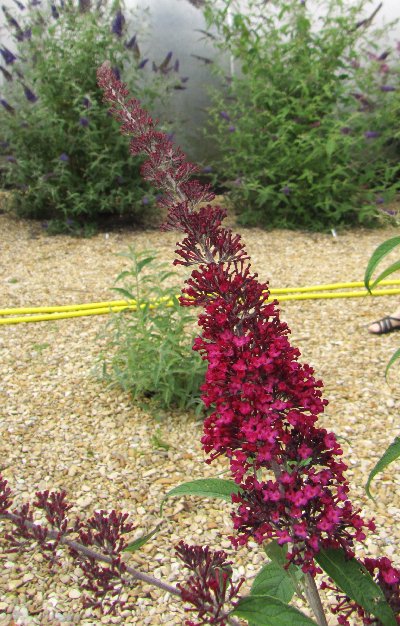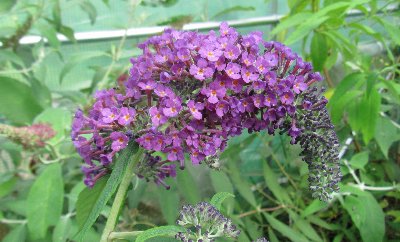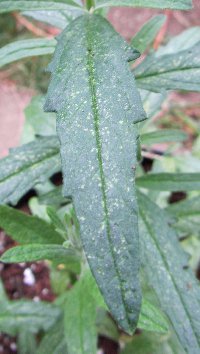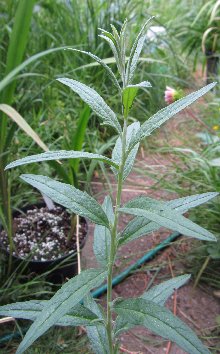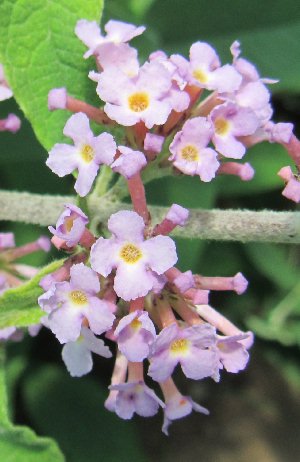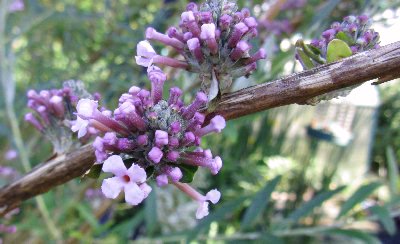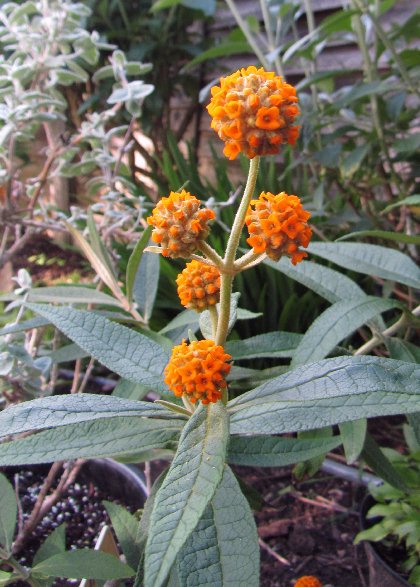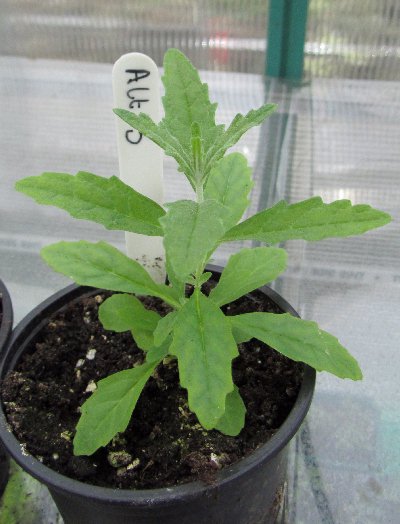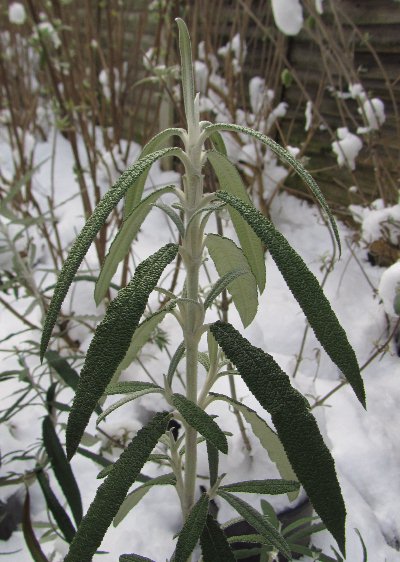
2013 Buddleja Calendar
October 2013
|
The second full season for The Buddleja Garden is coming to a close. It was another challenging year that started with the cold, snowy April but developed into a pleasantly warm summer. I had just one casualty this year and that was probably due to the wet summer last year rather than the late spring this. I have learnt a few lessons along the way and learnt about many new Buddlejas. One lesson learnt this year is that you just can't tell much about a Buddleja seedling in the first year or two even if it flowers. I have observed how several of mine have matured slowly with both the flower colour and form not stabilising until possibly their third year; pot grown plants can be deceptive so planting into the ground is necessary to properly assess a plants potential and ultimate size. This is rather bad news for the amateur Buddleja breeder as significant space (at least two square metres each) will be required to trial the seedlings and they will occupy that space for at least two full seasons. Last year on a visit to Longstock Nursery I noticed their Les Kneale was much pinker than my own. The flower colour of the Longstock specimen has been likened to strawberry milkshake. My plant came from The Lavender Garden and is virtually white with only a touch of lilac, but otherwise is the same. Flower colour can vary with conditions and I decided the only way to check would be to plant a Longstock plant alongside my own so that their conditions would be exactly the same. When they flowered there was still a noticeable difference, although rather difficult to capture with a camera. The almost white form is considered the original type from the Isle of Man and the pink version a sport that must have arisen during rounds of propagation. |
|
|
Camberwell Beauty is prone to reversion to these plain mauve flowers. |
The last two months I have lamented the fact that inferior cultivars often are all you can find in Garden Centres and that the AGM isn't always a true reflection of the best available. Camberwell Beauty is one of the Butterfly series of smaller Buddlejas from East Malling Research in Kent. In 2010 it was awarded the AGM and that is thoroughly undeserved. The flowers are big and branched and a pleasing purple; according to the RHS report the effect is much like a miniature Dartmoor. But that isn't quite true: the flowers do not open in a coordinated pattern on the panicle and look untidy; much worse the plant is has a serious reversion problem. Last year I speculated that it was a artificially induced sport of a fairly basic mauve Buddleja as it keeps producing shoots with single, mauve panicles and different leaves. Probably a cultivar best avoided. |
|
|
|
Buddleja weyeriana Variegata is a rare plant, as it has failed to catch gardeners' imaginations. The variegation is not at all obvious for much of the year and also an acquired taste as it is in the form of random yellow speckles rather than at the margins, but I like it. Apparently it was once sold as Flight's Fancy but is more generally known as just 'Variegata'. It is a sport of Sungold and has the clear yellow flowers in balls on an interupted panicle typical of all the Weyeriana cultivars. From late summer on the variegation becomes more and more pronounced which adds interest over and above Sungold. Some leaves even become predominantly yellow, but these are few in number. |
Salmon Spheres should also be a popular hybrid with its unusual pink-yellow globes that appear both in the spring and the autumn, and it is flowering again now. The foliage is soft, felted and grey inherited from one of its parents, B. crispa. And I have found it to be pretty hardy and evergreen, even with this spring's late snow. But I have also found one possible reason why it didn't take off; actually it does take off and is a very vigorous and messy grower. It appears to be rather lax but it is possible that it will become increasing upright with age as it forms older wood. Pruning is a bit of a conundrum as it flowers at both ends of the year, probably best done after the spring flowers have faded or even early spring sacrificing the first flowers. |
More of the Flutterby series are going to be available in the UK from next year courtesy of Seiont Nurseries. These will be the Flutterby plants: Lavender, Pink and Peace. This is confusing so perhaps I should explain there are four groups of Flutterby Buddlejas: Flutterby Grande are the larger plants; Flutterby are the smaller cultivars; Flutterby Petite are the very dwarf varieties described previously; and Flutterby Flow are the low growing ground cover Buddlejas. All claim to be seed sterile and hence non-invasive. |
There are jobs to do at the end of October. Before the first hard frosts it is best to put away tender species and hybrids, a cool greenhouse is all that is necessary for all but the most tender, tropical species. Ventilation is critical as they can be prone to damage from moulds such as Botrytis in cold, damp air. Dead-heading of all the B. davidii cultivars and hybrids is best completed by the end of October - be a good neighbour and avoid giving everybody self-sown seedlings in the spring. If you have a windy garden it is best to reduce the height by about a third to prevent wind rock that can damage the roots, but don't prune fully until next March-April. The Diary takes a rest for the winter but will return in the spring, hopefully an early warm one! |
September 2013
|
The upside of a very late spring is that many Buddlejas are still flowering well into September. Dead-heading extends the flowering period and a second flush of flowers, even a third is possible well into the autumn, although the flowers do get progressively smaller and the colours can become more muted. The Buddleja x weyeriana hybrids don't often set much seed so will flower continuously until the first frosts. The cultivar Autumn Beauty, a plant with a string of synonyms, is supposed to flower much later than the B. davidii cultivars, but in this aberrant year has flowered at the same time. | |
Much has been made of the colour break represented by Miss Ruby, Sugar Plum and Buzz Red. All three are very striking; Buzz Red (also known as Buzz Velvet) is particularly bright. And these are set to be joined in America by another supposedly red cultivar, the intriguingly named CranRazz from Ball Horticultural. Summer Beauty is a much older hybrid cultivar from Horticultural Research International, Boskoop, Netherlands and a full sibling of Pink Delight. It is a neat, restrained Buddleja and has deep rose pink flowers, not as near to red as Sugar Plum, but still a very impressive shade; it is actually one of the parents of Sugar Plum. It didn't really take off as a popular cultivar in the nursery trade because it is harder to propagate and is not as robust as most cultivars, but has been unjustly overlooked. |
The same fate seems to be destined for the recently introduced Darent Valley. This is probably the best white cultivar and it has an RHS Award of Garden Merit (AGM). It is easy to propagate and very robust; it is also very upright and has exceptionally large flowers which seem to repeat endlessly, yet it is being ignored by much of the trade. Nurseries and garden centres prefer to stick to older, inferior varieties or else are promoting the newer sterile dwarf hybrids. The true blue flowered Blue Horizon, also with a recently awarded AGM, has not been able to supersede the inferior Empire Blue either. Both these cultivars are well worth the extra effort to track down. Darent Valley was collected from the wilds of Kent and I too have found several fine Buddlejas growing on urban wasteland. My favourite is a very pale pink with dark buds and this year it has big open and stepped panicles. It seems the odd distribution of anthocyanins that makes the buds purple but the flowers almost white extends to the seed capsules, which are a very bright red. It is not unusual to see these pigmented in darker cultivars but rarely such a bright shade. |
|
I have mentioned my Buddleja albiflora seedlings for the last two months; I was unsure whether they were hybrids or not. I am now pretty sure most are hybrids with B. davidii, as I have been told by Peter Moore (curator of the Longstock Collection) that these two species hybridise readily producing fertile offspring despite the chromosome number mismatch. The flowers of most of my seedlings are just too showy to be pure B. albiflora with the single exception of the one described in August. Several of these B. albiflora x B. davidii putative hybrids have set seed when open-pollinated - what will the next generation be like especially as I don't know what the pollen parent is likely to be? As usual there is no systematic research into such hybrids, and the only precedent in the literature is a hybrid of the hexaploid B. stenostachya (a form of B. nivea) crossed with tetraploid B. davidii. R.J. Moore (1949) (no relation to Peter) reported this hybrid was a perfect intermediate between the species and that it was not self-fertile, although this does not necessarily mean sterile. The hybrid was pentaploid, again intermediate between the species. See: Moore, R. J. (1949). Cytotaxonomic studies in the Loganiaceae. III Artificial hybrids in the genus Buddleia. L. Am. J. Bot. 36, p. 511-516. 1949. | |
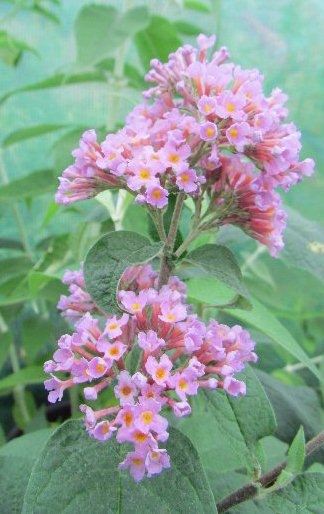 | |
|
Some other seedlings are also growing nicely. My B. alternifolia seedlings are developing into plants that are clearly not hybrids but perfect replicas of the parent. It always pays to try and grow species from seed as you learn more about the plants. There is nowhere that tells you that B. alternifolia has an immature stage with opposite toothed leaves and that the alternate smooth-edged leaves only develop later. Exactly the same has been the case with my B. loricata seedlings: as they have developed the leaves have become more and more similar to the parent. So I have learned this year that some species have immature forms and that B. loricata is self-fertile. B. alternifolia is a variable species in the wild although most plants in the UK are clones. There is also the Argentea cultivar, a smaller weaker version with silvery leaves. The Dutch botanist Leeuwenberg in his monograph sunk several botanical specimens under B. alternifolia including a high altitude species called Buddleja tsetangensis, a plant very similar to B. alternifolia with alternate leaves and cream to pale yellow flowers. A recently collected plant from high altitude in Tibet matches the original description of B. tsetangensis and it has been brought into cultivation under the name B. wardii KR4881. I am cautious about the identification as B. x wardii, which is considered a naturally occurring hybrid of B. alternifolia and B. crispa with a tendency to produce both opposite and alternate leaves. KR4881 seems to only have alternate leaves that are an interesting grey and toothed variation on B. alternifolia's foliage. Whichever name you prefer it is available from Pan-Global Plants. |
|
August 2013
This month is always the most exciting in the Buddleja year. Not only do most of the plants flower now but we get the added interest of the butterflies coming to feed - they do love a Buddleja. Peacock butterflies have been in great numbers this year and I have seen a dozen other species, all in urban Birmingham, including Painted Ladies that haven't been as far north for a few years. It seems just like the Buddlejas the butterflies have been able to catch up after the very late spring. Peacocks are one of our most common butterflies and the most colourful. As usual it is only the Peacocks that stay still long enough to be photographed, all the other species are more skittish! |
My Buddleja albiflora seedlings have been growing well and I am no nearer deciding whether they are hybrids or examples of species variation, or most likely some of each. Several are exactly like the species other than they have dark lilac flowers. Such coloration is found in the wild and it is a mystery as to why the name albiflora (white-flowers) was finally adopted. The species was also named B. hemsleyana for the botanist W.B. Hemsley, although it was Hemsley himself who originally coined the name B. albiflora. The rule is to use the earliest verifiable name, however inappropriate. |
|
Another contentious species is B. limitanea. The botanist Leeuwenberg described this as a mere small variant of B. forrestii in his Buddleja monograph, probably erroneously. The individual flowers are bigger than B. davidii with a much more open throat and shorter, fatter corolla tube. This year it has produced large pendulous panicles of mauve-purple flowers; indeed these panicles are rather similar to those produced by B. forrestii. I am not sure whether it will be fully hardy but I have seen it growing outside happily in rural Herefordshire. Mine is in a large pot to be taken inside for the winter but is likely to be planted outside next spring. 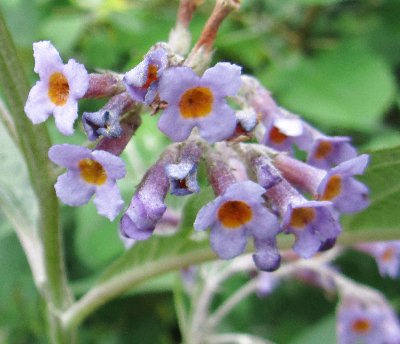 B. limitanea flowers are larger than most others in the genus |
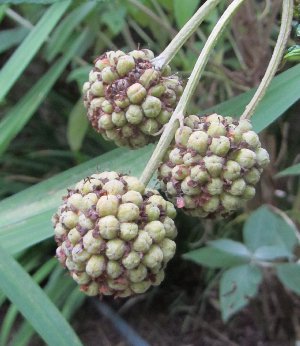 B. globosa has prodiced very full seed capsules after pollination by a male B. araucana.Over the last two years I have had a few seed capsules on B. globosa, the source of the pollen being something of a mystery - Salmon Spheres and B. globosa HCM98017 being possibilities. This year I deliberately placed B. araucana (formerly B.nappii and also called B. globosa var. araucana) alongside and, although a young plant, it flowered well. The B. globosa flowers nearest to B. araucana have swollen into huge conglomerates of seed capsules, at 3-4cm diamteter far larger than anything I have seen previously. The cultivated form of B. araucana is clearly a male plant producing pollen compatible with B. globosa and I am looking forward to raising the offspring. This raises an interesting point: whereas Leeuwenberg lumped many of the Asian Buddlejas together into fewer species, Eliane Norman (author of the monograph on American Buddlejas) has split these broadly similar plants into separate species. So should I describe the offspring of B. globosa and B. araucana as interspecific hybrids or as intermediates between varieties? |
|
I have had a few discussions this summer about the new 'red' cultivars, although they are all in fact an intense cerise pink. Sugar Plum from Peter Moore is a fine upright plant growing to about 2 metres with quite long panicles. Miss Ruby is a slightly smaller plant with brighter flowers courtesy of a more visible yellow eye. But for all its merits Miss Ruby (which has the RHS Award of Garden Merit or AGM) has very small panicles, making the plant underwhelming to say the least. It seems rather unfair that the superior Sugar Plum was overlooked for an AGM. Buzz Red is a relative newcomer and so far appears to have quite long panicles of very bright flowers, but as far as I can tell the growth habit is less refined than either of the others and it grows larger than the other members of the Buzz series. Lo and Behold Purple Chip (syn. Purple Haze) is another newcomer and has unusual bright purple flowers. As I have only just obtained this plant I can't really say how it will perform in the garden, but it is looking good in a pot. It's a complex hybrid and a close relative of Blue Chip, which has disappointed failing to flower for me two years in a row. |
|
I have raised numerous B. davidii seedlings over the last few years and most are fairly routine types. Every now and again something different will appear and this year I have what I hope will prove a new flower type. A cross of two unnamed plants has produced a plant with cup shaped flowers, purple with a white centre in the interior. A few cultivars have flowers that are dished rather than opened flat, especially when under stress, but I have never seen the effect as extreme or as consistent. I suspected the shape may be an artefact from growing in a small pot and being too dry, but the second flush of flowers is exactly the same despite more diligent watering and feeding. Another issue to consider is that Buddleja seedlings actually take several years to mature and show their true form, so next year I could find I have a completely average open flower. 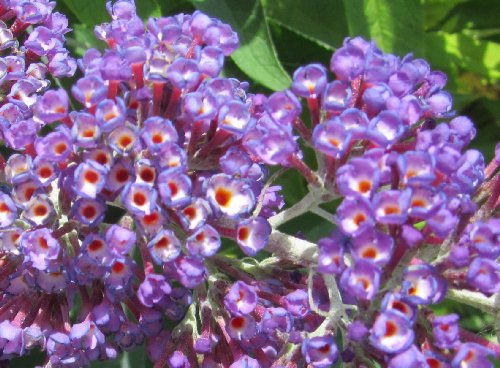 Up close showing the white interior.Sometimes the unusual does prove to be constant. Last year I found a plant with heavily branched white flowers. I thought the cuttings I took would not come true but they have and I am very pleased with the plant as it doesn't seem as vigorous as many other white cultivars. For now I have called it Snowmageddon. | 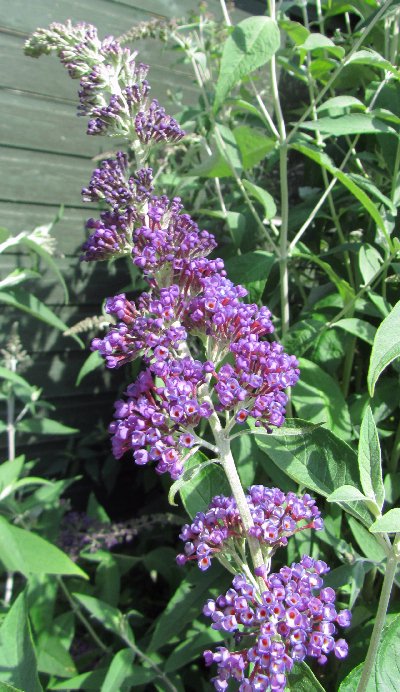 An un-named seedling with unique cupped shaped flowers and a white centre on the interior. |
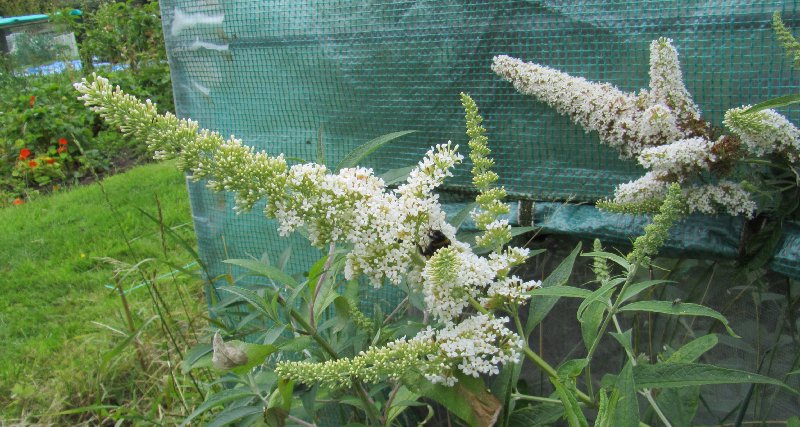
A wild collected plant with branched white panicles.
Snowmageddon is its temporary name.
July 2013
At last, some hot weather. All Buddlejas are growing fast now, most are quite drought tolerant so are coping well without much rain, although it has now rained hard at the end of the month. Plants in pots, however, do need constant watering. It isn't without some risk, though, and the nasty little two-sptted spidermites are making an appearance. Less than a millimetre across and fast breeding they feed on the underside of leaves causing white spots to appear on the upper side as they eat the cell contents. Outdoor plants are usually cured when it rains as the spidermites hate moisture but glasshouse plants can really suffer as they are progressively weakened by the damage to their leaves. Misting plants in the greenhouse helps or you can buy predatory mites that eat and then outbreed the pest. Pesticides are practically useless as the mites mutate and evolve resistance so quickly. They have developed a taste for my Buddleja alternifolia seedlings. Incidentally, the seedlings are now producing only alternate leaves, so possibly aren't hybrids after all. It seems there is a juvenile stage in this species with toothed, opposite leaves |
|
On the subject of putative hybrids I have been growing a number of B. albiflora seedlings from an open pollination amidst dozens of B. davidii cultivars. My thanks to Andrew Bullock (The Lavender Garden) for the seeds. The plants are rather varied with different leaf types, varying stem pigmentation but all are deciduous and have round rather than sub-quadrangular stems, a distinguishing feature that separates B. albiflora from B. davidii. There are three hypotheses for the parentage: | |
|
These plants are now flowering and in several the flowers at first appearance look more like B. davidii than B. albiflora, as the flowers are very pink and larger than the species. But closer examination shows that the corolla tube is slightly conical and full of hairs, both feature of B. albiflora. The scent is very light and unlike B. davidii. Are these plants examples of species variation or hybrids?  The B. albiflora seedling (left) has flowers that look like B. davidii and rather unlike the species (right). | |
|
The first Buddleja davidii (or a hybrid of it) to flower has been Thompson & Morgan's Colour Fountain Blue. A rather curious plant, this, and still less than 50cm tall. It has very small, narrow foliage but the flowers are bluish lilac and not blue and the claim for the longest panicles is a bit far-fetched. This plant is an off-shoot of Charles Valin's Buzz Buddleja breeding programme and has been selected for a very low growth habit. First impressions suggest some Nanhoensis in the background with its very narrow leaves. There are also possibly several new colours of these ground-cover Buddlejas coming from Thompson & Morgan in the near future. Colour Fountain Blue also has bears a resemblance to several of the new Flutterby Petite plants from Peter Podaras in both foliage and habit although it is 100% B. davidi and not a B. davidi X B. alternifolia hybrid like the latter. Some Buddleja News from the Horticultural Trades Association National Show late in June. The industry trend really is towards the small, sterile Buddlejas as these start to out-sell the traditional plants. Eagle Plants is preparing four of the diminutive Flutterby Petite series for full garden centre release next year under the Free Petite name: Blue Heaven, Snow White, Dark Pink and Tutti Fruiti. Some of these are already available mail order as small plants but it is probably better to wait for the larger garden centre plants. Brandsford Webbs has abandoned full production of Lo and Behold Buddleia Red Chip (called Miss Molly in the USA) due to propagation problems but are full steam ahead with other Dennis Werner introductions: Lo and Behold Blue Chip, Lilac Chip, Purple Chip (Purple Haze) and White Chip (Ice Chip) all joining the excellent Miss Ruby. Purple Chip looks most interesting with its robust-looking foliage and pendant purple flowers. Lo and Behold Red Chip is still available from a few European nurseries and it is a rather inbred cultivar. It is a seedling from Miss Ruby x Attraction, Miss Ruby itself being a cross of Attraction and White Ball. The flowers are a pleasing shade but are essentially the same colour as Miss Ruby, maybe a shade darker, the selling point being that it is a smaller plant. What is remarkable is that Red Chip and Miss Ruby share a colour with Sugar Plum and Buzz Red despite differing pedigrees, although I believe they all ultimately derive fom Royal Red. The reason would seem to be down to chemistry - this shade is the closest to red that Buddleja davidii can produce with the pigment producing enzymes it currently has. Only a significant mutation or (gasp!) genetic engineering are likely to deliver a true red. Next month all the B. davidii cultivars and hybrids should be in full swing. | 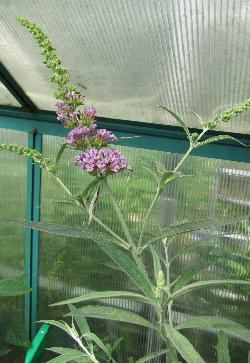 Buddleja Colour Fountain Blue is also called Foot Long and has flowers that are lilac rather than blue.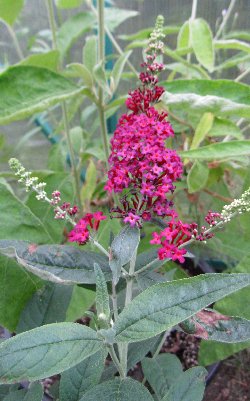 Lo and Behold Red Chip is also called Miss Molly and has flowers that are a similar shade to its parent Miss Ruby. |
 Lo and Behold Purple Chip joins Blue Chip, White Chip (not shown), Lilac Chip (not shown) and Miss Ruby in the UK. | |
June 2013
Spring was late starting but now everything is finally catching up. The first B. davidii flowers buds are forming already so they are mostly at the same stage as this time last year. A few weaker plants may still lag behind but not for long. Species that have normally flowered by the end of May are only just starting to come into bloom now at the end of June. Buddleja alternifolia is just starting to flower now although it has been in leaf for some time, as is Buddleja globosa: delayed but getting back on track. This is a great opportunity for hybridisations because species that normally flower over a month apart could be in flower at the same time. |
|
There are a few cultivars of Buddleja globosa but the origin of many plants is unknown. My plant has large dark green leaves and bright orange flowers but others have paler flowers and smaller leaves. Buddleja araucana (formerly called B. nappii) is a very similar species but can flower a little earlier in a normal year. It seems most of the specimens in the UK are derived from a shrub at Kew Gardens in London. B. globosa comes from the western Andes in Chile whilst B. araucana is more easterly, found in the eastern Chile and Argentinean Andes and the same area as the Monkey Puzzle Tree (Araucaria araucana). Although virtually indistinguishable the ranges of the two species do not overlap and there is not any evidence for intermediate types between the two species. The diagnostic feature, at least according to David Stuart who wrote the RHS Plant Guide on Buddleja, is the brown tomentum on the underside of the leaves, stems and flower buds of B. araucana. The leaves are also narrower and less bullate (that is a less crinkled top surface) than B. globosa. In the wild B. araucana is something of a xerophyte living in dry regions where the differences must be accentuated; it seems to be the soft life in England that makes it so much like B. globosa. 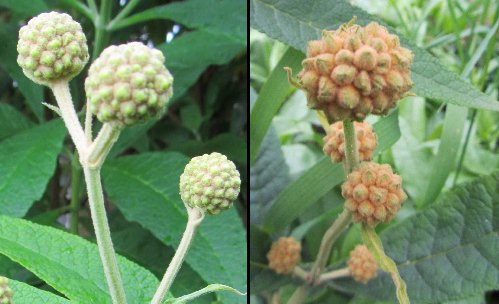 The buds of B. globosa (left) are different to those of B. araucana (right). |
On the subject if identification: I have my doubts about the commonly available B. caryopteridifolia. The original description from the 1920s describes the plant as having very toothed leaves and this specimen was later sunk as a B. crispa by the botanist Leeuwenberg in 1979. The B. caryopteridifolia in the National Collections has smooth leaves and this is the same plant that I have. It is very hardy but deciduous and it is flowering now. It seems to flower fairly randomly in the early summer and/or autumn and sometimes twice in the same year. But the leaves are smooth and occasional branches have alternate leaves so it doesn't match the original description at all. Intriguingly, the flowers have the same scent as B. alternifolia and not at all like B. crispa. To me they smell of rose and chlorine whereas B. crispa has a refined honeyed spice perfume. There are hybrids between B. alternifolia and various B. crispa varieties. A plant found in the wild is B. x wardii is considered a hybrid of the two although this is sometimes treated as a separate species as there is no solid proof of its hybrid origin. There are several hybrids bred by horticulturalists, the best known is B. x pikei mentioned below. I suspect the plant currently identified as B. caryopteridifolia is a hybrid but which one? | 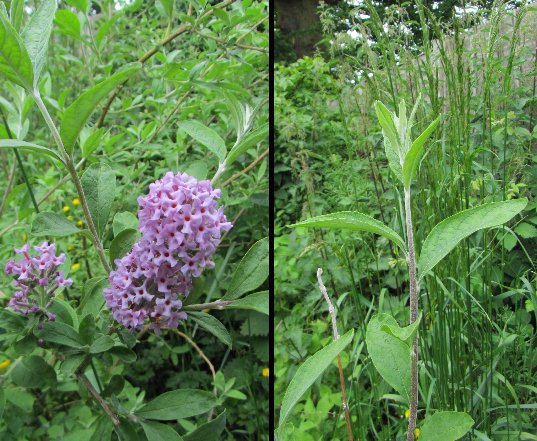 The plant usually identified as B. caryopteridifolia (left) is flowering now. The smooth edged leaves are usually opposite but some brances have alternate leaves (right). |
|
Naming is always a problem for the plant collector. Species are difficult enough but cultivars can be really chaotic and the horticultural trade does little to help. Thompson & Morgan's Colour Fountain Blue is called Foot Long by the sister company Van Meuwen (I will maybe come back next month to look at this plant) and Buzz Red becomes Buzz Velvet. Names are frequently different in Europe and the USA. Lo and Behold Miss Molly has become Red Chip in Europe, not to be confused with Miss Ruby which is sold under its original name in the UK. Ice Chip has been changed to White Chip and Purple Haze is renamed Purple Chip. And it works the other way too: Argus Velvet and White are now called InSpired Violet and White in the USA with B. x weyeriana Pink Pagoda thrown in as InSpired Pink. There are yet more new Buddleja cultivars, again from the USA: the Merry Magic Series (Purple, Violet and Orchid) promises to be well behaved and, although B. davidii, non-invasive due to a low seed-set. Next month we can look forward to the beginning of all those B. davidii flowers!. | |
May 2013
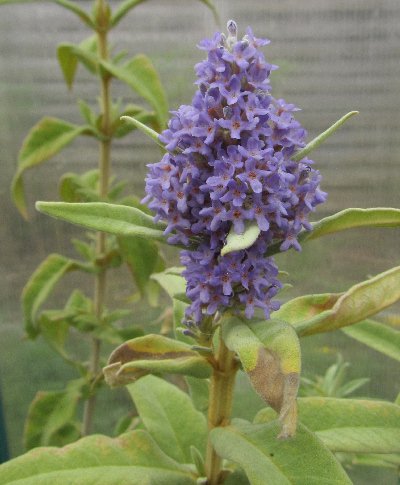 The flower panicles are much smaller this year on Buddleja salviifolia. | Spring is so late this year. The few warm days in May have allowed plants to catch up only a little and I would estimate everything is four to six weeks behind now. Temperatures are remaining stubbornly below average and the growing season is getting shorter all the time. Even under cover the low light levels are having an effect. The flower panicles on Buddleja salviifolia are a fraction of their size last year although at least they are more or less on time. Buddleja crispa var. sterniana suffered in the late snow and the flower buds were desicated in the cold wind. Out of hundreds of buds just a few tiny flowers have emerged - better luck next year. But at least the plant is coming back into leaf now. 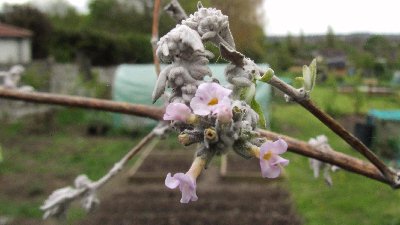 These few flowers are all that survived the winter |
|
Talking of flowers, I have noted an interesting phenomenon with Buddleja 'Salmon Spheres' over several years. In warm conditions, whether inside or out, the flowers are quite pink fading only at the very end. Where it flowers in cool weather the flowers are more yellow-buff with a hint of pink, as are the flowers on mine now it is planted outside. It is proving very hardy too and growing very fast now, although as a hybrid of B. globosa B. crispa and you would expect some degree of resilience. This is in stark contrast to Buddleja ‘Winter Sun', a plant I have yet to make flower. It's very similar as a hydrid of B. araucana (a species almost indistinguishable from B. globosa)) and B. officinalis but seems less forgiving of cold conditions. |
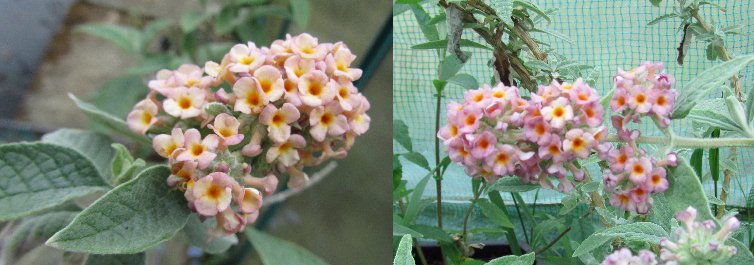 The colour of Buddleja Salmon Spheres depends on the conditions. |
|
I think my B. lindleyana had a bad year last year and the late spring has done for it. Unusually it lost all its leaves last autumn and no buds have appeared yet. It has a bit of a reputation, along with the related B. japonica, for being short-lived in some circumstances. It also has a bad reputation for suckering, but on this occasion this is an advantage. Several new little plants are springing up about 50cm away so I will be able to start again but obviously in a different position. The difficult decision is what to replace it with - so many choices! | 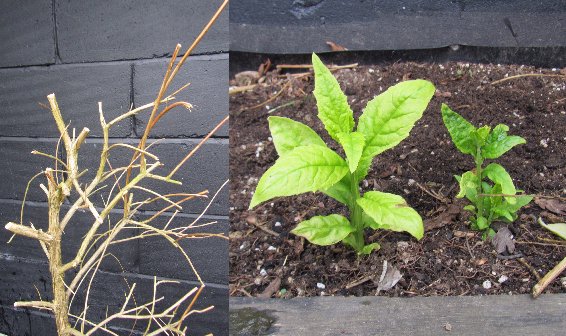 Buddleja lindleyana appears to have died but is still throwing up suckers. |
|
The seedlings I described last month have continued to develop. Its quite clear now that all the B. alternifolia seedlings are hybrids - I have a tray of twelve and they are all more like B. crispa than the seed parent. Likewise the B. loricata seedlings still have leaves unlike the seed parent and I can't even guess at the pollinating species yet. I will come back to these again as the summer progresses. Finally, a variegated Buddeja davidii cultivar I have recently acquired. Sir John comes from Stone Green Nurseries in Kent and has foliage similar to Santana but with the yellow/green a bit more randomly distributed. The flowers are pink-purple but I will have to wait until July-August to see these. |
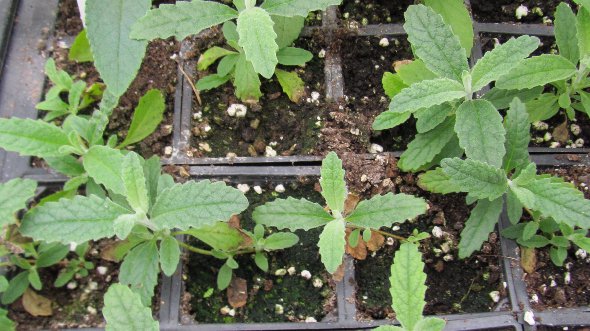 These Buddleja loricata seedlings look unlike the parent plant - | 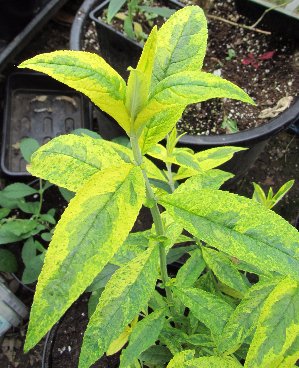 Buddleja davidii Sir John has foliage like Santana |
April 2013
|
Last time I said that last winter hadn't been too bad. And then came March, with snow and freezing temperatures for much of the month. The worst March since 1963 and then a cold start to April, although the second half is heading to be average. This means there is little going on now. Even the winter foliage remaining on the B. davidii cultivars was frazzled in the cold winds but most of those dead leaves are removed at pruning anyway. The pruning of B. davidii and its hybrids needed to be left until the freezing nights had passed, and actually mid-April is a perfect time to prune for an August show of flowers when those newly emerged butterflies are on the wing. Many plants still look dead but will soon start greening up again. Sadly all the B. crispa var. sterniana flower-buds were destroyed in the constant cold east wind. Unless the early spring flowering plants are in a particularly sheltered spot (or under some form of cover) there is always a risk that the flowers will be lost to the cold. But tiny green shoots are starting to appear from the bare stems so all is not lost. 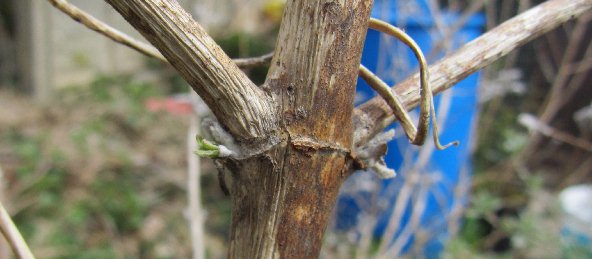 The flowers may be lost but Buddleja crispa var. sterniana is starting to recover. | 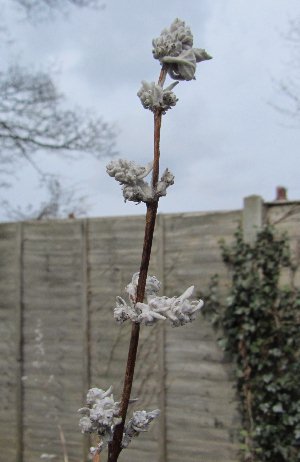 Buddleja crispa var. sterniana has had its exposed flower-buds killed and dessicated by the cold wind. |
|
|
One thing that was possible in March was to sow seeds. A warm windowsill is a good place or a heated propagator is even better for the seed trays. Some seeds benefit from a little cold treatment, others don't but I have not systematically tested which do benefit. I kept all sorts of seeds last year but those from the species Buddlejas are most interesting. The genus Buddleja is quite promiscuous with species from different continents happily hybridising. Buddleja Silver Anniversary (syn. Morning Mist) is a cross of Asian B. crispa and African B. loricata; there are many examples of Asian/American hybrids: B. x weyeriana and Salmon Spheres for example. So where there are many species jammed in together you never quite know what you will get in the next generation. There hasn't been much systematic research into self-compatibility and self-incompatibility in Buddleja but it is known that B. davidii doesn't self-pollinate. Some others may be able to such as B. crispa var. farreri and B. yunnanensis. Many species from the Americas have separate male and female plants (dioecy) so the question doesn't arise for them. I have been told that B. alternifolia might be self-compatible but it seems likely that out-crossing is more favoured. The seedlings that are developing now from its seeds look nothing like the parent, with opposite leaves that have crenate (wavy), not smooth, margins. It is possible that immature plants don't resemble the adult but it is far more likely that these are hybrids, probably B. caryopteridifolia providing the pollen. I have been told that B. alternifolia hybrids can grow into large ugly shrubs. There is no guarantee that this hybridisation will lead to a worthwhile plant but it has been tried already. B. alternifolia X B. caryopteridifolia is known as B. x pikei after a hybrid made by a Mr. A.V. Pike at Hever Castle in Kent, the best cultivar named Hever. |
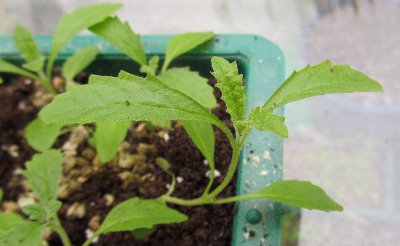 The B. loricata seedlings also have toothed leaves very unlike the species so are these hybrids or just an immature form? | Buddleja loricata also produced copious fertile seed but I expected this to be the result of self-pollination. The seedlings are uniform but again look suspiciously unlike the seed parent with ovate, toothed leaves. Will they develop the smooth-edged strap-like leaves of B. loricata (see the picture below) or are these hybrids too? If they are hybrids will they be of any horticultural merit? Only time will tell. |
March 2013
|
After winter the Buddleja Diary is back for the 2013 season! But not many flowers to see yet. This winter has been mostly mild but so very wet. Temperatures have often been below freezing but only just even in the snow, unlike a couple of years ago. Many exotic Buddleja need a mild winter to survive outside but he constant damp can be an equal problem. Waterlogged soil can be lethal for Buddlejas, even B.davidii. Disease can get in, especially the fungus Phytopthera sp. which will kill even a well established plant by damaging the main stem at ground level. Botrytis is another fungal problem, mostly under cover. Fortunately this attacks the leaves and only in exceptional cases killing the plant, late summer cuttings being the most vulnerable. It is always worthwhile removing affected leaves and cutting away parts that show the fuzzy grey mould. Some plants have proved to be much hardier than expected. And much happier planted outside rather than kept in a pot under cover. B. loricata hails from South Africa but usually grows at altitude so needs some resistance to cold. Mine has continued to grow slowly all winter and is totally unfazed by snow. Salmon Spheres, a hydrid of B. crispa and B.globosa, is considered a rather tender hybrid with similar needs to B. crispa. My greenhouse plant is reduced to few leaves and looks rather sad whereas one planted outside has thrived in the snow, keeping all its leaves and even its flower buds. Perhaps its hardiness is akin to the other parent, B.globosa, which is pretty tough but often looks a bit sad in the snow. |
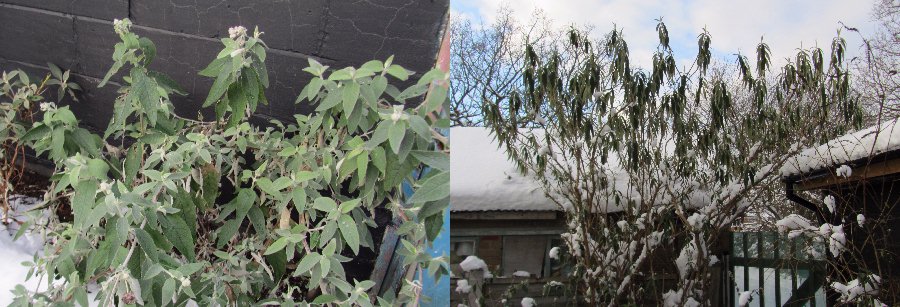
Salmon Spheres (left) coped well with the snow. Buddleja globosa (right) looks stressed but is fully hardy.
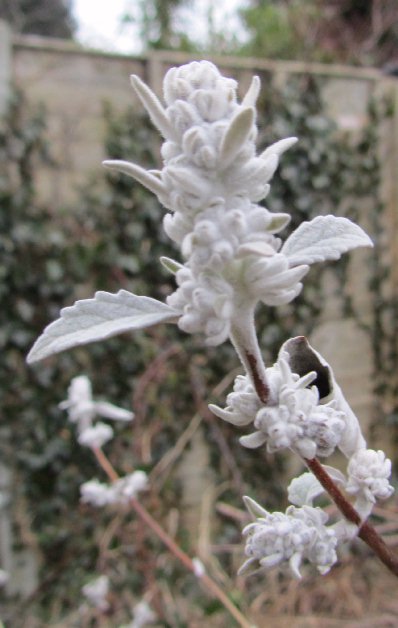 Buddleja sterniana seems hardy
| B. sterniana, or more correctly B. crispa var. sterniana, had proved hardy over several years although is cut right back in the hardest winters. This year it look like most of the flower buds have survived the cold and has even retained some foliage. Like many spring bloomers it forms buds in the autumn which can be lost to the winter, but when these survive they open late March or in April depending on the conditions. It seems the endless stream of new, diminutive and virtually sterile Buddlejas continues. Peter Podaras from the USA, who gave us the 15 strong Flutterby Series, has four more plants out. One is a smallish plant, Purple Splendor. The others are really small, creeping types which will be marketed in Europe under the names of Dreaming Lavender (Lavender Veil in North America), Dreaming White (Angel White) and Dreaming Purple. So small they are considered suitable for hanging baskets. As with Flutterby these are complex hybrids and there are many more in the pipeline. The Argus series comes to us from Ghent, Belgium and these are hybrids of B.davidii and B.lindleyana. Small and sterile they are marketed as non-invasive. Argus Velvet is a purple and Argus White is, well, white. Last year Bransford-Webbs introduced Lo and Behold Lilac Chip to the UK but the release of Red Chip (originally called 'Miss Molly' in the USA) was delayed. This year Red Chip will be available alongside two more Lo and Behold plants, Purple Chip (syn. Purple Haze) and White Chip (syn. Ice Chip). |
|
What will happen to all these new small Buddlejas? There will probably be a selection process with just the best surviving. The market can't support so many plants and many will disappear from the catalogues, becoming extinct. Do we need a National Collection of miniature Buddlejas to preserve them? Probably not. Don't forget it will soon be time to prune those long-day (summer) flowering species, especially B. davidii, to keep them neat and floriferous. This February has been very cold so wait until late March or even early April. See: A Guide to Pruning Buddleja davidii. RETURN TO THE HOMEPAGE | |
